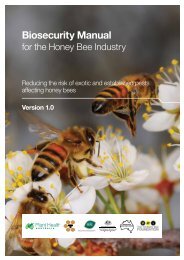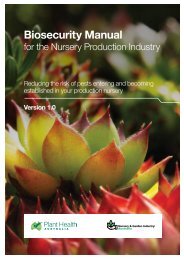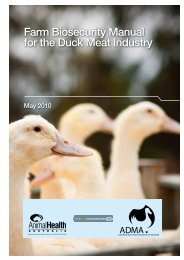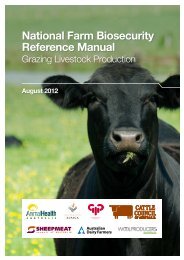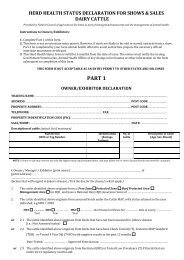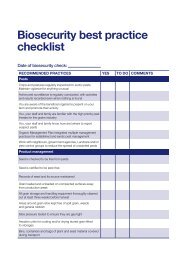Orchard Biosecurity Manual for the Mango Industry - Farm Biosecurity
Orchard Biosecurity Manual for the Mango Industry - Farm Biosecurity
Orchard Biosecurity Manual for the Mango Industry - Farm Biosecurity
You also want an ePaper? Increase the reach of your titles
YUMPU automatically turns print PDFs into web optimized ePapers that Google loves.
Fact sheet<br />
<strong>Mango</strong> gall midges<br />
What are <strong>Mango</strong> gall midges?<br />
<strong>Mango</strong> gall midges (Procontarinia spp.) are a range<br />
of damaging fly species. The different species<br />
can attack leaves [such as <strong>Mango</strong> leaf-gall midge<br />
(P. matteiana)], which reduces photosyn<strong>the</strong>sising<br />
capacity), flowers (affecting fruit set), shoots or fruit<br />
(blemishing <strong>the</strong> fruit).<br />
What do <strong>the</strong>y look like?<br />
In some species <strong>the</strong> eggs are laid into tender leaves,<br />
causing small reddish spots (oviposition marks).<br />
The tissue under <strong>the</strong>se spots becomes soft.<br />
Gall <strong>for</strong>mation begins within a week and attain<br />
<strong>the</strong>ir maximum diameter of 3-4 mm be<strong>for</strong>e <strong>the</strong> larva<br />
is even 0.5 mm. Adults usually emerge from <strong>the</strong> lower<br />
side of <strong>the</strong> leaves, leaving <strong>the</strong> pupal skin protruding<br />
from <strong>the</strong> emergence hole. Heavy oviposition in leaves<br />
causes <strong>the</strong>m to dry and curl up.<br />
What can <strong>the</strong>y be confused with?<br />
Galls are distinctive raised spots or bumps.<br />
O<strong>the</strong>r spots or lesions (not raised) may be<br />
caused by <strong>Mango</strong> scab (a fungus), Stigmina leaf<br />
spot, Fruit spotting bugs or mechanical damage.<br />
What should I look <strong>for</strong>?<br />
Eggs are laid onto leaves causing small, red spots.<br />
The most prominent symptom is <strong>the</strong> presence of<br />
wart-like galls up to 4 mm in diameter on <strong>the</strong> leaves<br />
and occasionally on stems or fruit. Heavily galled<br />
leaves may curl up and drop prematurely, causing<br />
dieback of whole branches in susceptible mango<br />
cultivars.<br />
How does it spread?<br />
<strong>Mango</strong> gall midge is spread by wind currents and<br />
long distance dispersal is through movement of<br />
infested plant material.<br />
Eggs are laid onto leaves causing small red spots<br />
Galls can appear wart-like<br />
Leaf photosyn<strong>the</strong>tic capacity can be greatly reduced<br />
DEEDI DEEDI<br />
DEEDI



